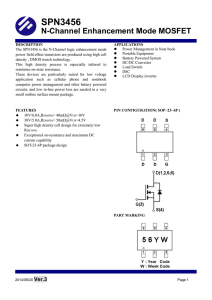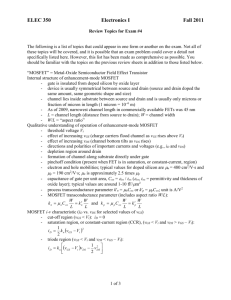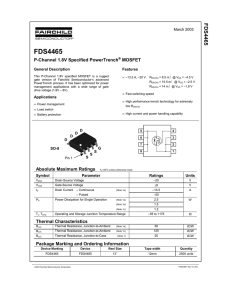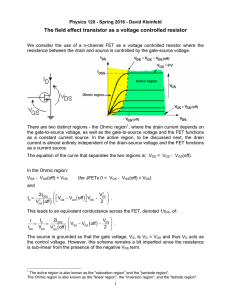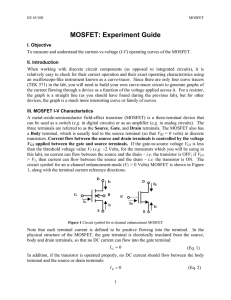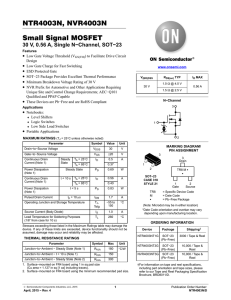MOSFET Physics: The Long Channel Approximation
advertisement
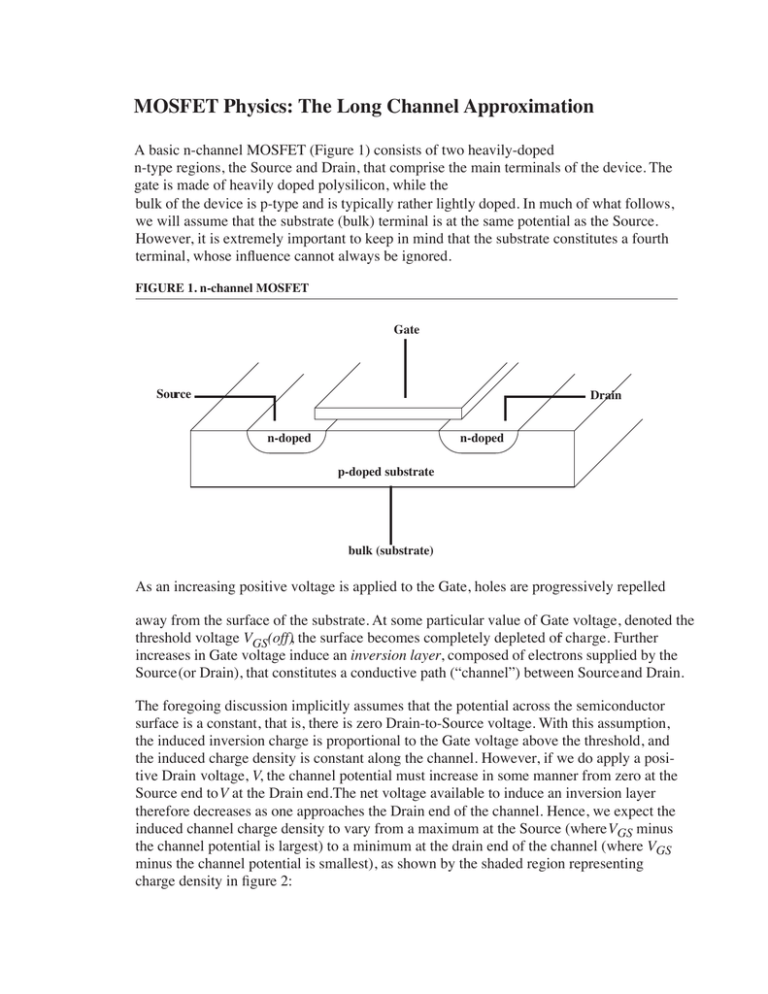
MOSFET Physics: The Long Channel Approximation
A basic n-channel MOSFET (Figure 1) consists of two heavily-doped
n-type regions, the Source and Drain, that comprise the main terminals of the device. The
gate is made of heavily doped polysilicon, while the
bulk of the device is p-type and is typically rather lightly doped. In much of what follows,
we will assume that the substrate (bulk) terminal is at the same potential as the Source.
However, it is extremely important to keep in mind that the substrate constitutes a fourth
terminal, whose influence cannot always be ignored.
FIGURE 1. n-channel MOSFET
Gate
Source
Drain
n-doped
n-doped
p-doped substrate
bulk (substrate)
As an increasing positive voltage is applied to the Gate, holes are progressively repelled
away from the surface of the substrate. At some particular value of Gate voltage, denoted the
threshold voltage VGS(off), the surface becomes completely depleted ofr cha rge. Further
increases in Gate voltage induce an inversion layer, composed of electrons supplied by the
Source (or Drain), that constitutes a conductive path (“channel”) between Source and Drain.
The foregoing discussion implicitly assumes that the potential across the semiconductor
surface is a constant, that is, there is zero Drain-to-Source voltage. With this assumption,
the induced inversion charge is proportional to the Gate voltage above the threshold, and
the induced charge density is constant along the channel. However, if we do apply a positive Drain voltage, V, the channel potential must increase in some manner from zero at the
Source end to V at the Drain end.The net voltage available to induce an inversion layer
therefore decreases as one approaches the Drain end of the channel. Hence, we expect the
induced channel charge density to vary from a maximum at the Source (where VGS minus
the channel potential is largest) to a minimum at the drain end of the channel (where VGS
minus the channel potential is smallest), as shown by the shaded region representing
charge density in figure 2:
FIGURE 2. n-channel MOSFE T (shown at boundary between Ohmic region and Active region)
gate
source
drain
n+
n+
p-substrate
bulk (substrate)
Specifically, the channel charge density has the following form:
ρn( x ) = − C ox { [ V GS − V ( x ) ] − VGS(off) }
(1)
where ρ n(x) is the charge density at position x, Cox is εox/tox and V(x) is the channel potential at position x. We follow the convention of defining the x-direction as along
the channel. Note also that Cox is a capacitance per unit area. The minus sign simply
reflects that the charge is made up of electrons in this nMOS example.
This last equation is all we really need to derive the most important equations governing
the terminal characteristics.
Drain Current in the Ohmic Region
The Ohmic region of operation is defined as one in which VGS is large enough (or
VDS small enough) to guarantee the formation of an inversion layer the whole distance
from source to drain. From our expression for the channel charge density, we see that it
has a zero value when
[ V GS − V ( x ) ] − VGS(off) = 0
(2)
The charge density thus first becomes zero at the drain end at some particular voltage.
Therefore the boundary for the Ohmic region is defined by
[ V GS − V DS ] − VGS(off) = 0 → V DS = V GS − VGS(off) ≡ V DSAT
(3)
As long as VDS is smaller than VDSAT , the device will be in the Ohmic region of operation.
Having derived an expression for the channel charge and defined the linear region of operation, we are now in a position to derive an expression for the device current in terms of
the terminal variables. Current is proportional to charge times velocity, so we’ve just about
got it:
I D = − W ρn ( x ) v ( x )
(4)
The velocity at low fields (remember, this is the “long channel” approximation) is simply
the product of mobility and electric field. Hence,
I D = − Wρn ( x ) µ n E
(5)
where W is the width of the device.
Substituting now for the channel charge density, we get:
I D = − W C ox [ V GS − V ( x ) − VGS(off) ] µ n E
(6)
Next, we note that the (x-directed) electric field E is simply (minus) the gradient of the
voltage along the channel. Therefore,
dV
I D = µ n C ox W [ V GS − V ( x ) − VGS(off) ]
dx
(7)
I D dx = µ n C ox W [ V GS − V ( x ) − VGS(off) ] dV
(8)
so that
Next, integrate along the channel and solve for ID:
L
V
∫ ID dx
0
= ID L =
DS
∫ µn Cox W [ VGS − V ( x ) − VGS(off) ] dV
(9)
0
At last, we have the following expression for the Drain current in the Ohmic region:
}
ID
2
V DS
W
= µ n C ox
[ V GS − VGS(off) ]VDS −
L
2
}
(10)
Note that the relationship between Drain current and Drain-to-Source voltage is nearly linear for small VDS. Thus, a MOSFET in the Ohmic region behaves as a voltage-controlled
resistor.
Drain Current in Saturation
When VDS is high enough so that the inversion layer does not extend all the way from
Source to Drain, the channel is said to be“pinched off.” In this case, the channel charge
ceases to increase, causing the total current to remain constant despite increases in VDS.
Calculating the value of this current is easy; all we have to do is substitute VDSAT for VDS
in our expression for current:
}
ID
2
V DSAT
W
= µ n C ox
[ V GS − VGS(off) ] V DSAT −
2
L
which simplifies to:
ID =
µ n C ox W
2
L
}
[ V GS − VGS(off) ] 2
(11)
(12)
Hence, in saturation, the Drain current has a square-law dependence on the Gate-Source
voltage, and is (ideally) independent of Drain voltage.
The transconductance of such a device in saturation is easily found from differentiating
our expression for drain current:
g m = µ n C ox
W
[ V GS − VGS(off) ]
L
(13)
which may also be expressed as:
gm =
2µ n C ox
W
I
L D
Thus, a long-channel MOSFET’s transconductance depends only on the square-root
of the bias current.
(14)





